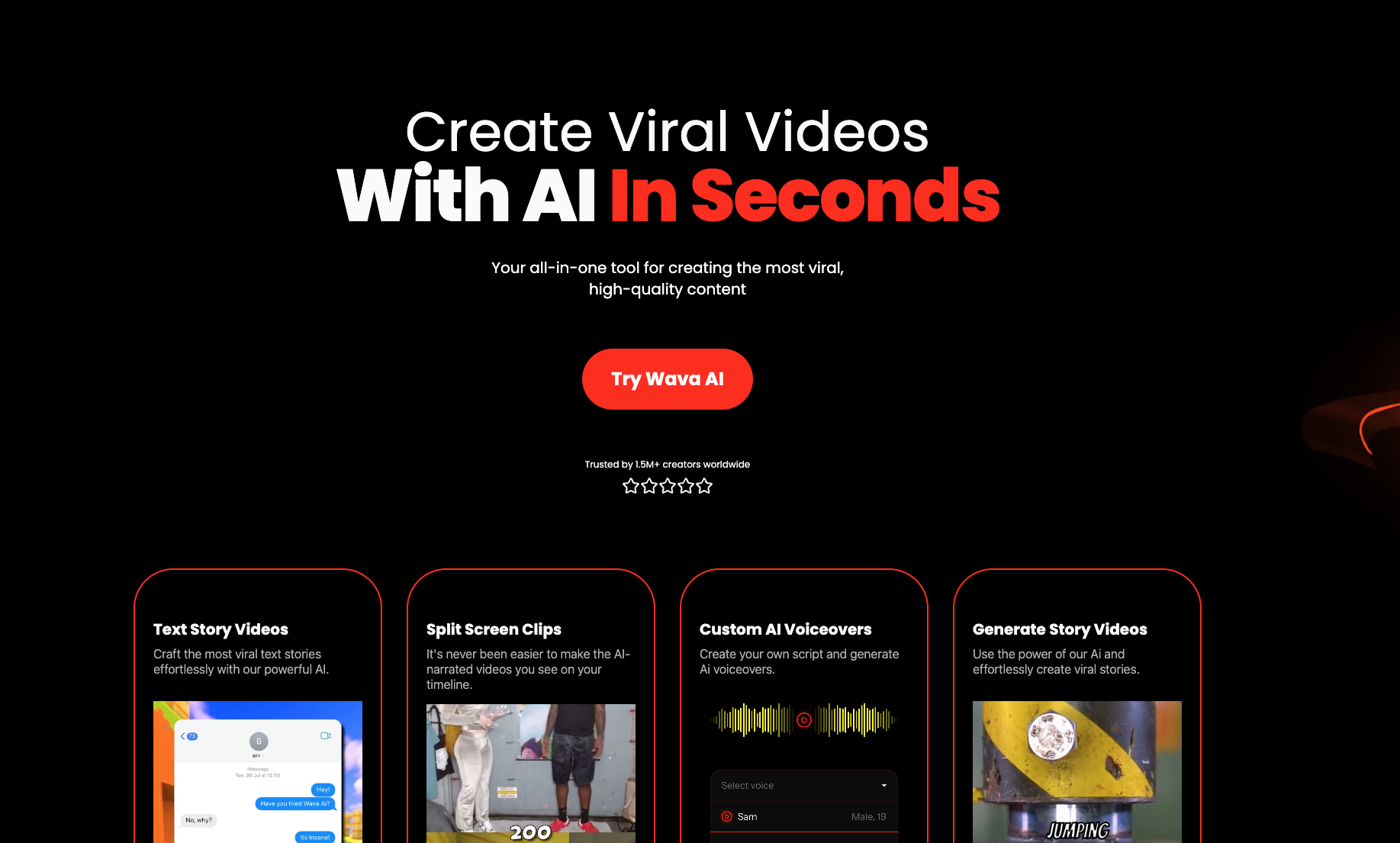
Wava AI aims to turn text ideas into short videos that feel ready for social feeds. I spent several evenings pushing scripts, prompts, and random stories through it, just to see what breaks first.
The promise is direct, remove editing pain and return clips that look native to TikTok and Reels. In practice, the tool meets you halfway, then asks for a little taste and style. I liked that the learning curve stayed gentle while the outputs grew steadily better with tweaks.
The homepage sells a clear outcome, create viral videos quickly, with templates and voices that do most heavy lifting. What impressed me early was the balance between automation and small human adjustments that keep results personal. I nudged pacing, trimmed a sentence, swapped a background, and felt in control. When a platform invites edits without friction, you keep experimenting rather than give up.
That is a quiet win in a noisy market.
What Wava AI actually offers
The feature set covers text story videos, split screen clips, captions, and custom voiceovers. Templates give you a structured starting point, so you never stare at an empty canvas wondering what to press. I liked that scripts can be pasted straight in, then matched with stock backgrounds and an AI voice in one sweep. The whole flow feels like a conveyor belt for short video production, which suits solo creators and lean teams. If you have ever wrestled with timelines and keyframes, this approach feels refreshing.
Pricing lands in the accessible zone, with a free trial window and a starter subscription afterward. The trial lets you judge quality on your own footage instead of trusting marketing samples, which I always prefer. Paid tiers unlock more monthly renders, faster generation, priority support, and extras like ElevenLabs voice options. Cost per clip trends reasonable once you publish consistently, which is where short video earns its keep anyway. If you only post twice a month, the free tier might be enough for a while.
A quick list of real use cases
-
Creators who want text driven story videos without touching full editors
-
Agencies building faceless brand shorts at volume for new product pushes
-
Coaches repurposing long posts into snackable explainers their audience can share
-
Meme pages testing formats fast, then doubling down on what gets watch time
-
Founders previewing landing page narratives as short video before a campaign goes live
Hands on impressions and workflow fit
Speed matters, and Wava keeps you moving from prompt to preview in a few clicks. I wrote a short story, selected a calm voice, and had a usable clip within a minute. The split screen format worked well for social proof, pairing text on one side and motion on the other. Auto captions behaved, though I still reviewed punctuation since rhythm changes with different voices. Small edits stack quickly, and that momentum reduces procrastination more than any pep talk.
Cleaner scripts
Quality depends on sensible inputs, which sounds obvious until you paste a messy paragraph at midnight. Cleaner scripts yield tighter pacing, while cluttered drafts feel choppy no matter the template. The background library is decent for generic scenes, though niche footage still benefits from manual uploads. I appreciated the ability to tweak timing rather than accept a fixed cut, which kept my tone intact. When a video finally matched the story in my head, I did a small victory lap in the kitchen.
Value, limits, and alternatives to watch
On value, Wava hits a sweet spot for solo creators who need reliable throughput more than cinematic control. Compared with manual editing, you save hours each week that can be spent on scripting and distribution. The edges show up with highly specific visuals or heavy brand guidelines, where you will still open a traditional editor. If your work lives in strict review cycles, keep a human in the loop for caption checks and brand voice. For a second opinion, creator reviews and directories echo the same strengths and caveats in broad strokes.
Conclusion
Wava AI is a practical companion for short video creation, especially when the goal is consistency over perfection. It offers a friendly runway from idea to output, with enough control to make clips feel yours. I would not hand it every campaign without review, yet it earns a seat in the weekly toolkit. For creators who publish often, the balance of speed, templates, and voices delivers dependable mileage. Try the trial, set a small publishing goal, and see if your watch time moves in the right direction.
Keep one alternative
If you adopt it, write a simple playbook that covers script length, voice choice, caption review, and background rules. That document will save you more time than any single feature, and it helps collaborators stay aligned. Keep one alternative tool nearby for specialized scenes, then compare results on the same script. Measure performance, not vibes, and you will know quickly whether Wava deserves the monthly slot. Either way, you end the week with more published videos and fewer excuses.
I still cannot get it to cook dinner, but at least my clips look good.
